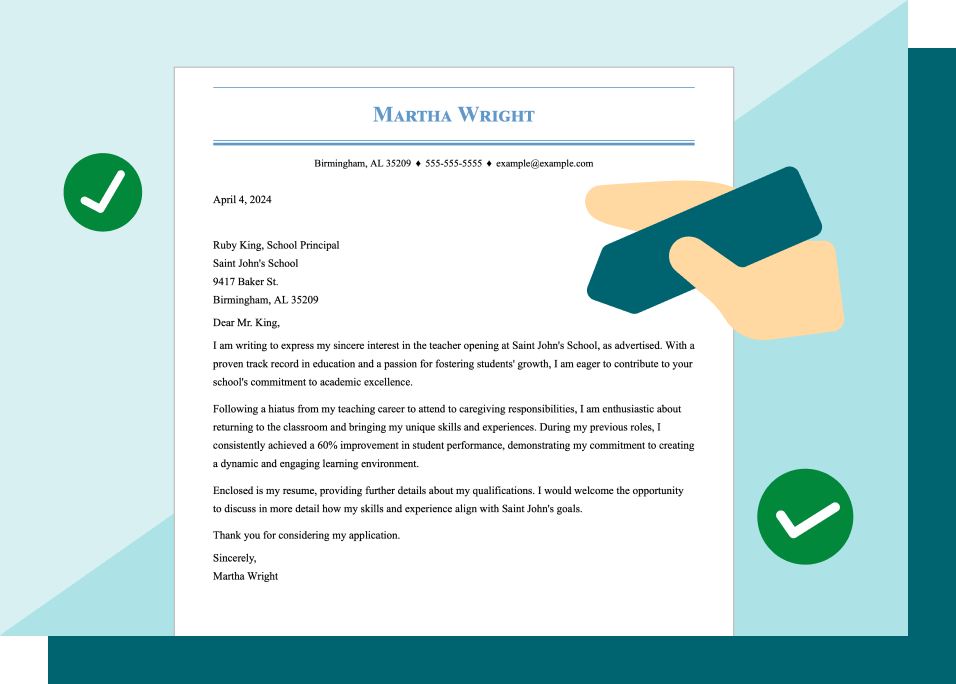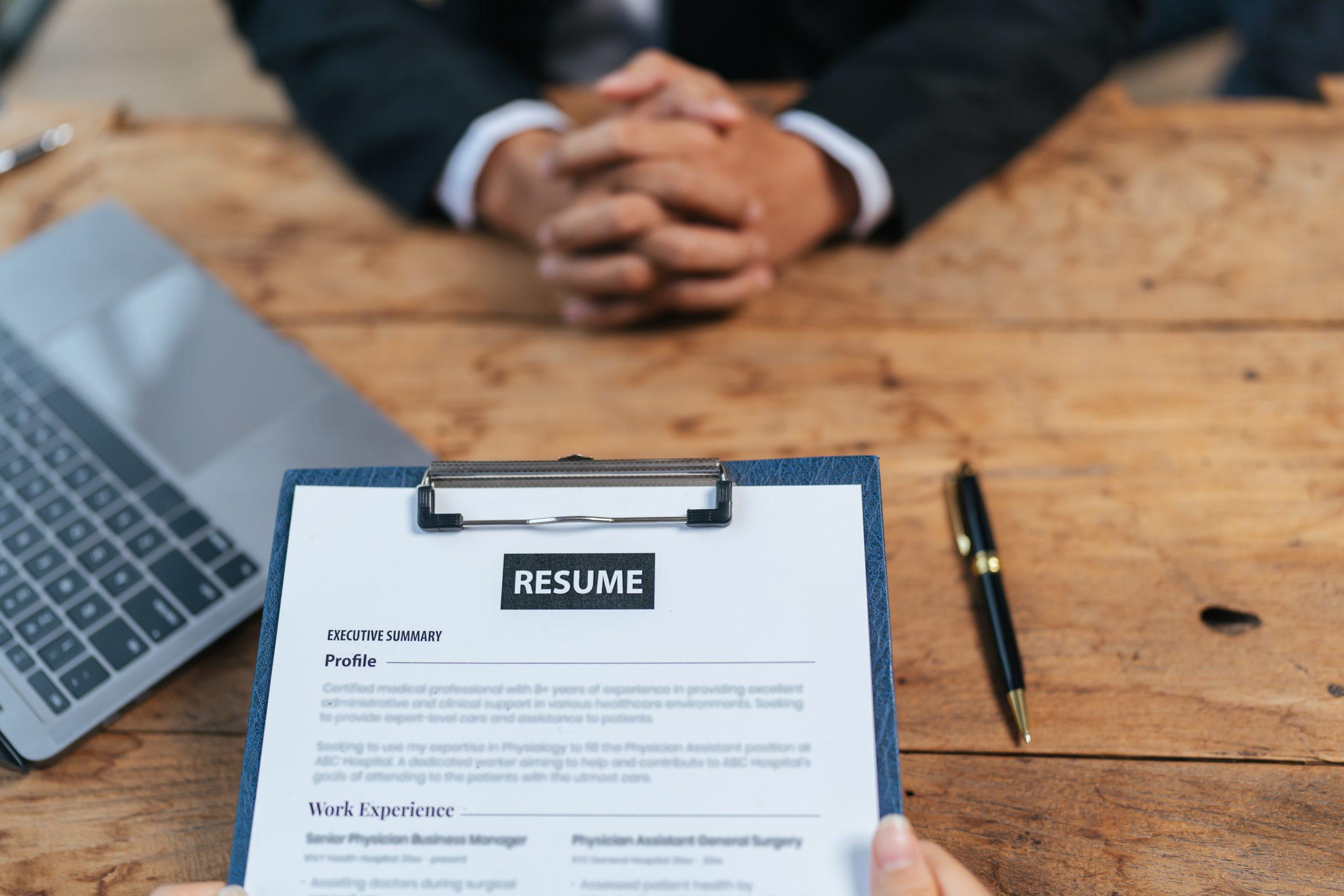How to Write a Resume for an Internal Position Examples
When applying for a position within your current company, you must customize your resume to play to unique strengths like company insight, loyalty, and relevant skills. Our writing guide and examples are here to help you land that promotion!
What Is an Internal Resume?
An internal resume refers to a resume a job seeker writes when applying for a job within their current company. When writing a resume for an internal position, you’re likely vying for a promotion.
You’re competing against outside candidates who can bring a fresh set of skills and a new perspective; therefore, you’ve got to play to your unique strengths as a current employee.
An internal resume’s structure won’t differ from a professional resume’s. This type of resume is unique because you will highlight your internal knowledge of the company, such as processes, business needs, culture and leadership demands.
In addition, as an internal candidate, you’ve already built a reputation with supervisors and colleagues who can vouch for your abilities and professionalism.
Internal Resume Template
Check out this internal resume template, which includes the five essential resume sections while focusing heavily on the candidate’s history with the company, past successful projects and the profits resulting from their efforts.
Now, we’ll go into more detail on how to write each section of your internal resume to compel your company to give you the job. However, you can skip ahead and let our Resume Builder write you a custom resume in minutes!
How to Write a Resume for an Internal Position
Let’s go through each step of making a resume for an internal position that shows employers your growth within the company and convinces them you have what it takes to take the next step in your career.
Step 1: Choose a resume format that suits your needs.
Before you begin writing your resume, remember that you can use three recruiter-approved resume formats. The traditional chronological resume format is the most common, but this format isn’t necessarily the best for every job seeker.
As someone applying for an internal promotion, the combination format is an ideal choice since it features a resume objective and doubles down on the importance of skills. After all, the company might already have an idea of what you’ve achieved these past few years, but being able to list the skills, training or certifications you’ve acquired is a great way to catch their attention instantly.
Step 2: Reinforce your strengths in the resume objective.
The resume profile in an internal resume should speak to your career progression within the company and your unique insights as a current employee. Your best approach for this section is to write a resume objective statement that states how you’ve helped the company succeed and the skills you’ve gained that warrant a promotion.
Here’s an example of a resume objective for an internal position:

Step 3: Include a summary of qualifications.
The summary of qualifications is unique to combination resumes and can give you a leg-up when competing with external applicants.
This section follows your resume objective and contains a few bullet points contextualizing your skill set.
You should take advantage of this section’s prime real estate on your resume to focus on the most essential job requirements, such as necessary skills, experience or other qualifications like training or knowledge of a specific tool.
Check out this internal resume summary of qualifications example. This candidate is applying for an internal role that requires many technical skills and know-how on the product side.
Summary of Qualifications
- Strong foundation in product management, including close collaboration with product development teams to launch successful new products.
- Skilled in UX design principles, ensuring user-centered marketing strategies that align with product goals and enhance customer experiences.
- Proficient in project management, overseeing end-to-end product marketing initiatives from concept to launch.
- Solid understanding of the product lifecycle and the ability to develop strategies that support product growth and innovation.
Step 4: Focus on quantifiable achievements in your work experience.
Your internal resume’s work experience section should include measurable achievements that prove the impact of your efforts.
Instead of listing your job duties and general responsibilities, show your current employer that you’ve helped them increase their profits or productivity. Include numbers, percentages and dollar amounts to create quantifiable accomplishments that capture the recruitment team’s attention.
As the saying goes: “put your money where your mouth is,” and your employer will find it hard to argue that you’re the best person for the job.
Here’s an example of a work experience entry for an internal resume:
Marketing Specialist
BrightWave Media – Boulder, CO
June 2019 – Present
- Spearhead digital marketing campaigns that boosted lead generation by 25% in Q2 2023, contributing to 17% overall revenue increase for the quarter.
- Lead cross-functional team to develop comprehensive rebranding strategy, resulting in 30% increase in website traffic and 22% increase in social media engagement within the first six months.
- Collaborate with the product development team to launch three new products, contributing to 31% year-over-year growth in product sales.
Step 5: Showcase skills indicating professional growth.
When making a resume for an internal position, the skills section is where you should show recruiters that you are more than your current role.
When your company recruiter looks at your updated resume, they don’t want to see the same skills you had on the resume you submitted when you first applied.
Instead, focus on the new skills you’ve developed at the company and highlight those you’ve acquired in preparation for this new role. Show your company you’ve put in the work to deserve this promotion.
Here’s an example of a skills section for someone who wants to pivot from their social media role to project manager:
Skills
- Proficient in Agile and Scrum methodologies
- Experienced in Asana, Trello and Jira
- Budget management experience
- Risk assessment and mitigation strategies
- Gantt charts and performance dashboards
- Communication skills and stakeholder management
- Adaptability
- Analytical thinking
Step 6: Use your education section to show continuous learning.
Along the same lines of showing professional growth, the education section is the place to show employers you’ve taken the initiative to expand your professional knowledge.
You’ll, of course, still include essential education information such as:
- Your degrees
- College or universities you attended
- Location of the colleges
However, you may expand your resume’s education section to feature additional education, such as:
- Advanced degrees (include expected graduation date if not completed)
- Certificates or associate degrees to supplement your studies
- Professional training related to the role
- Online courses (Udemy, Coursera)
Here’s an example of an education section for someone applying for an internal role:
Education
Master of Business Administration (MBA) – In Progress
University of Southern California (USC) – Los Angeles, CA
Expected Graduation: May 2025
Certified Project Management Professional (PMP) – Project Management Institute, 2023
Bachelor of Arts in Marketing
University of California, Los Angeles (UCLA) – Los Angeles, CA
Customize your internal resume with additional sections.
Depending on your desired role’s requirements and qualifications, you can add extra sections to account for more professional achievements.
When writing a resume for an internal position, consider adding the following sections: Only add these sections if you can include two or more items.
Are you ready to build your resume? Our Resume Builder allows you to take advantage of our easy-to-customize professional resume templates. There is no need to worry about formatting; the Builder will help you fit everything neatly into one page.
Do’s and Don’ts of Writing an Internal Position Resume
Before you press send to that email or upload your resume, review this checklist to ensure you maximize your internal position resume and avoid common mistakes.
- Use your insider knowledge to tailor your resume to reflect the company
- Speak the company language by including company-specific terminology and mentioning key organization pillars that can help resonate with decision-makers.
- Include references and feedback from team leads or positive performance reviews that emphasize your credibility. However, don’t add these to your resume; keep them in a separate document.
- Assume everyone knows you. Don’t skip essential resume details because the hiring manager may know you personally. Keep your resume professional and include the necessary information.
Be too casual. Professionalism is still vital. Playing to your strengths is fine, but be wary of sounding overconfident, as this can be offputting.
- Overemphasize tenure over results. Avoid focusing solely on how long you’ve been in the company. Respect the hiring process by prioritizing your achievements and qualifications.
Write a Cover Letter that Complements Your Internal Resume
When applying for an internal position, the cover letter is your best tool to convince recruiters to offer you the job.
Many external applicants forgo the cover letter because they want to apply to multiple jobs quickly. As a current employee, writing a cover letter helps emphasize your commitment to the company and your problem-solving skills.
Beyond a list of skills and past accomplishments, employers also want to hire applicants ready to hit the ground running and provide solutions. As an internal candidate, you possess all the knowledge to prove that hiring criteria.
A few topics you can cover in your cover letter for an internal position are:
- Your genuine interest in the company’s continued growth and success.
- Understanding company culture and how you will contribute to a professional and productive atmosphere.
- Actual solutions to current problems the company is facing (this will be your biggest asset as an internal applicant).
- Suggestions about improving operations that will benefit the company.
- Knowledge of established processes and procedures that won’t require an extensive onboarding process.
If you want to write a cover letter that looks polished, is well-formatted, and features valuable information for recruiters, try our Cover Letter Generator! You’ll have a personalized letter for any job or industry in minutes.
Frequently Asked Questions
How do I address gaps in my internal employment history?
If you have significant gaps in your employment history, you might be better off writing a functional format resume. You can also explain employment gaps in a cover letter or accounting the gap in your work history by stating any professional development you had during that break.
How do I explain the desire for a department change while staying within the company?
The place to explain your desire for a department change should be the cover letter. Mention your desire for growth and how your skills align with the new department’s goals while maintaining enthusiasm for the company.
Should I ask for feedback from my current supervisor before applying for an internal promotion?
Yes, requesting feedback from your supervisor before formally applying can provide insight into your readiness for the role and may give you helpful pointers to strengthen your application. Ask your supervisor for a one-on-one meeting to discuss your goals and how to approach this transition best.
What if I’ve had conflicts with coworkers or management in my current role — how should I address that on my resume?
Avoid directly discussing conflicts you’ve had with colleagues in your resume or cover letter. Save those discussions for HR if necessary. Instead, focus on how you’ve overcome challenges or improved in teamwork, emphasizing your ability to collaborate and grow.
How long should my resume be when applying for an internal position compared to an external role?
The type of role you’re applying for doesn’t impact how long your resume should be. Ideally, your resume will ideally be one to two pages long. However, if you have a long career history relevant to the role, you can go for one page per 10 years of experience.









